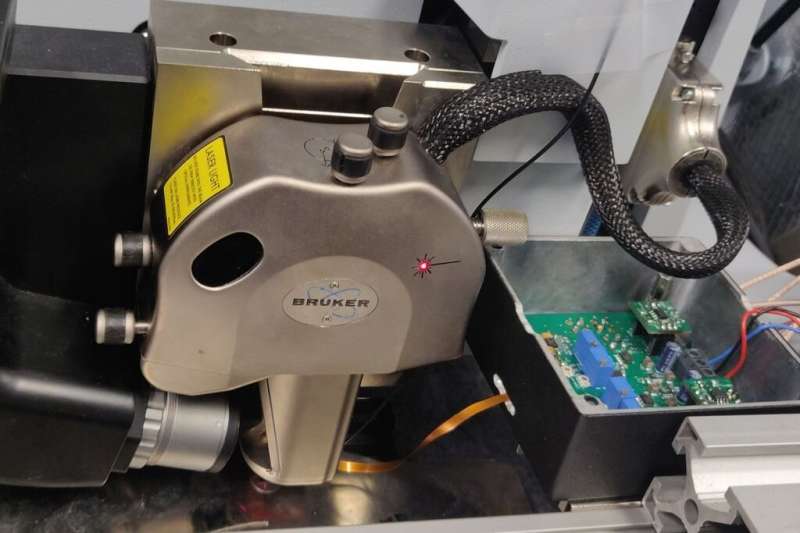New invention for more efficient atomic force microscopes

The basic principle of the atomic force microscope is very simple: an extremely thin, movable tip on a cantilever is moved over a surface that is being examined. Tiny forces on an atomic scale act between the tip and the surface and influence the movement of the cantilever. If the tip’s behavior is measured very precisely, information can be gained about the surface and a high-resolution image of the finest surface details can be created on the computer.
To achieve the necessary precision, relatively complex data processing technology is used today. TU Wien (Vienna) has now been able to show: There is a simpler way. A customized electronic circuit was built directly into the sensor element of an atomic force microscope (AFM), and its signal directly provides information about the state of the tip. The precision is just as good as with previous devices, but the new technology is much more compact, simpler and, above all, cheaper. The prototype is already working well, and now TU Wien is looking for industry partners.
Laser beams or precision electronics
“There are different methods to measure the movement of the tip,” says Mathias Poik from the Institute of Automation and Control Engineering (ACIN) at TU Wien. “For example, you can point a laser beam at the lever to which the tip is attached. If the tip moves a little bit, the laser beam is measurably deflected.”
But there are also atomic force microscopes that do not require a laser beam: You can make the tip vibrate and then measure electrically how the vibration changes over time. Piezoresistive materials are used for this: they change their electrical resistance when they are bent. The oscillation of the tip thus leads to an oscillating electrical resistance, and the signal is transmitted to a computer.
“The frequency at which the tip oscillates in the microscope is fixed,” explains Mathias Poik. “The important question for us is: with what amplitude does it oscillate? And where do phase shifts occur?” For example, if you scan a very hard area of the surface with the tip and then move it over a softer area, there is a change in the oscillation phase—the oscillation of the tip falls out of sync for a moment. If you measure this accurately, you can gain valuable information about the surface.
Electronics built directly into the sensor
“Reading amplitude and phase from this oscillation is no big problem—but today it is solved with relatively complicated and expensive measurement and data processing technology,” says Mathias Poik. “We have chosen a completely different approach: We build the essential element of data processing directly into the hardware, the signal is already processed before it is sent into a computer.”
An electronic circuit is built directly into the sensor to which the vibrating tip is attached. This circuit multiplies the signal from the tip (a sinusoidal oscillation) by another oscillation with the same frequency. “Mathematically, it’s easy to see: this multiplication creates a signal from which you can then read the amplitude and phase of the original oscillation very easily,” Mathias Poik explains.
“And this is done entirely without special sensors with high sampling rates and complex computer technology—but simply by means of a relatively simple electronic circuit that we have built directly into the sensor.” While conventional sensors use DC voltage, the new method works with AC voltage. Among other things, this means that the method is also well suited for measurements on liquids (for example, in biological samples).
Experiments have already been very successful: one achieves the same precision as with previous devices—but in a way that is simpler, more compact and cheaper. “There are already initial talks with manufacturers of atomic force microscopes to exploit this technology,” says Prof. Georg Schitter, head of the Advanced Mechatronic Systems Group at ACIN. “But we are also investigating other application areas of vibration measurement where this method can be used and thus improve or simplify instrumentation.”
More information:
Mechatronic Demodulation of AFM Cantilever Oscillation
Citation:
New invention for more efficient atomic force microscopes (2023, May 17)
retrieved 17 May 2023
from https://techxplore.com/news/2023-05-efficient-atomic-microscopes.html
This document is subject to copyright. Apart from any fair dealing for the purpose of private study or research, no
part may be reproduced without the written permission. The content is provided for information purposes only.
For all the latest Technology News Click Here
For the latest news and updates, follow us on Google News.

